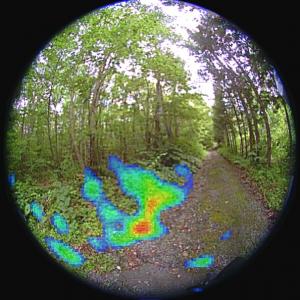Gamma ray camera may help with Fukushima decontamination*

The new Compton camera incorporates high-accuracy, three-dimensional, gamma ray position measurement technology developed at Waseda University. Copyright : Waseda University
Based on a high-sensitivity mobile gamma ray camera released by Hamamatsu Photonics in 2013, the new Compton camera incorporates high-accuracy, three-dimensional, gamma ray position measurement technology developed at Waseda University.
Led by Professor Jun Kataoka, the Waseda team improved the original camera’s resolution by about two times and enhanced its sensitivity by approximately 70%.
The new technology enables the smooth and accurate visualisation of gamma rays, which are invisible to the human eye, and could be used to help with the removal of radioactive substances from the Fukushima Daiichi nuclear accident.
The Waseda team is now working to make the detector even lighter and smaller: only 500 grams or less in weight and about 10 cubic centimetres in size.
Professor Kataoka plans to use the detector to advance
research on bio-function dynamics imaging and proton therapy.
For further information contact:
Professor Jun Kataoka
Research Institute for Science and Engineering
Waseda University, Japan
E-mail: kataoka.jun@waseda.jp
*This article also appears in Asia Research News 2015 (p.10).
Media Contact
All latest news from the category: Power and Electrical Engineering
This topic covers issues related to energy generation, conversion, transportation and consumption and how the industry is addressing the challenge of energy efficiency in general.
innovations-report provides in-depth and informative reports and articles on subjects ranging from wind energy, fuel cell technology, solar energy, geothermal energy, petroleum, gas, nuclear engineering, alternative energy and energy efficiency to fusion, hydrogen and superconductor technologies.
Newest articles

A universal framework for spatial biology
SpatialData is a freely accessible tool to unify and integrate data from different omics technologies accounting for spatial information, which can provide holistic insights into health and disease. Biological processes…

How complex biological processes arise
A $20 million grant from the U.S. National Science Foundation (NSF) will support the establishment and operation of the National Synthesis Center for Emergence in the Molecular and Cellular Sciences (NCEMS) at…

Airborne single-photon lidar system achieves high-resolution 3D imaging
Compact, low-power system opens doors for photon-efficient drone and satellite-based environmental monitoring and mapping. Researchers have developed a compact and lightweight single-photon airborne lidar system that can acquire high-resolution 3D…





















